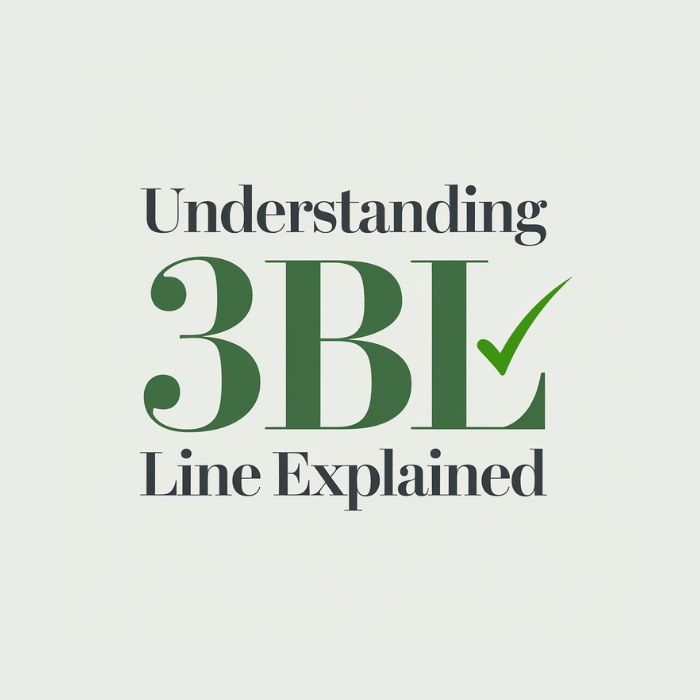Overview
In today’s fast-paced world, businesses face pressures beyond just turning a profit. Customers want to know that companies care about more than just their bottom line. They crave transparency and responsibility in how products are made and services are delivered. Enter the Triple Bottom Line (3BL), a transformative approach that shifts the focus from mere financial gain to a broader perspective encompassing social responsibility and environmental stewardship.
The concept of 3BL challenges traditional business models by emphasizing three critical components: people, planet, and profit. This holistic view recognizes that long-term success is tied not only to economic performance but also to fostering positive impacts on society and minimizing ecological footprints. As we delve deeper into what 3BL means for contemporary business practices, you’ll discover why this framework is gaining traction among forward-thinking organizations looking to make a meaningful difference while achieving sustainable growth.
What is the Triple Bottom Line (3BL)?
The Triple Bottom Line”3bl” is a framework that redefines success in business. It goes beyond traditional metrics like profit and loss, introducing a broader evaluation of impact.
At its core, 3BL encompasses three key dimensions: people, planet, and profit. Each aspect holds equal weight in assessing an organization’s overall performance.
People represent the social responsibility angle—how businesses treat employees, customers, and communities. Planet focuses on environmental sustainability—addressing resource usage and ecological footprints. Profit remains essential but isn’t the sole indicator of value.
This approach encourages companies to make decisions that not only drive financial growth but also contribute positively to society and protect our natural world. By embracing this model, organizations can foster resilience while creating lasting benefits for all stakeholders involved.
The Three P’s: People, Planet, Profit
The Triple Bottom Line revolves around three core components: People, Planet, and Profit. Each element plays a crucial role in shaping sustainable business practices.
People refer to the social impact of a company’s activities. Businesses must consider their employees, customers, and communities. Fair wages, safe working conditions, and community engagement are essential for fostering positive relationships.
Planet emphasizes environmental responsibility. Companies need to reduce waste, lower carbon footprints, and protect natural resources. Sustainable sourcing and eco-friendly production methods are becoming vital as consumers demand more from brands.
Profit is not just about financial gain but achieving economic sustainability while balancing the other two P’s. A healthy profit ensures that businesses can continue operating effectively while supporting social initiatives and environmental stewardship.
Together, these Three P’s create a holistic approach that encourages businesses to thrive without compromising ethical standards or ecological health.
The Importance of 3BL in Business
The Triple Bottom Line (3BL) framework reshapes how businesses define success. By incorporating social, environmental, and financial dimensions, it encourages companies to look beyond mere profit.
Embracing 3BL fosters a sense of responsibility. Organizations become more aware of their impact on communities and ecosystems. This awareness can cultivate loyalty among customers who prioritize ethical practices.
Moreover, focusing on sustainability often leads to innovation. Businesses that invest in eco-friendly processes frequently discover new efficiencies or products that appeal to conscious consumers.
Competitive advantage is another key benefit. Companies committed to the principles of 3BL attract talent and investors who value corporate responsibility.
Adapting to this model builds resilience against economic fluctuations. Firms with strong ties to their communities are often better positioned during crises, ensuring long-term viability while positively contributing to society and the planet.
Examples of Companies Incorporating 3BL
Several companies have successfully embraced the Triple Bottom Line framework, showcasing their commitment to sustainability.
Patagonia stands out with its dedication to environmental responsibility. The outdoor clothing brand prioritizes eco-friendly materials and actively participates in initiatives aimed at protecting natural habitats.
Unilever is another leader in 3BL practices. By focusing on sustainable sourcing and reducing waste, the company aims for a positive impact on both society and the environment while maintaining profitability.
Ben & Jerry’s embodies social activism through its business model. The ice cream maker supports fair trade practices and advocates for various social justice issues, aligning profit-making with purpose-driven efforts.
These companies demonstrate that integrating people, planet, and profit can lead to innovative solutions that benefit everyone involved. Their successes inspire others to follow suit in creating a more sustainable future.
Challenges and Criticisms of 3BL
While the Triple Bottom Line (3BL) presents an appealing framework for sustainable business, it faces several challenges. One major criticism is its vague nature. Defining what constitutes social and environmental impact can be subjective, leading to inconsistent measurements across industries.
Additionally, balancing the three P’s—people, planet, and profit—can create tension. Companies may struggle to prioritize one area over another without compromising overall performance. This conflict often leads to accusations of “greenwashing,” where businesses exaggerate their sustainability efforts without real commitment.
Moreover, implementing 3BL requires significant resources and changes in company culture. Small businesses might find it particularly daunting due to limited budgets or expertise in these areas.
Stakeholders often seek short-term gains rather than long-term sustainability goals. This pressure can deter companies from fully embracing a 3BL approach despite its potential benefits for future growth and resilience.
How to Implement 3BL in Your Business
Implementing the Triple Bottom Line in your business starts with a shift in mindset. Begin by assessing your current practices through the lens of people, planet, and profit.
Engage stakeholders at every level—employees, customers, suppliers. Their input is invaluable for creating a sustainable framework that resonates across your organization.
Next, set measurable goals. Whether it’s reducing waste or improving community engagement, clear objectives will guide you toward success.
Incorporate sustainability into decision-making processes. This means evaluating how each choice impacts social and environmental outcomes alongside financial ones.
Communicate transparently about your efforts and progress. Sharing successes and challenges fosters trust and encourages others to join the journey towards more responsible business practices.
Conclusion:
The Future of 3BL and Sustainable Business Practices
The future of the Triple Bottom Line (3BL) is promising. Businesses are beginning to recognize that success isn’t solely measured by profit margins. Instead, there’s a growing understanding that social responsibility and environmental stewardship play critical roles in long-term sustainability.
As consumers become more conscious of their purchasing decisions, companies must adapt. It’s no longer enough to focus on financial goals alone; businesses need to embrace ethical practices and sustainable operations. This shift can lead to enhanced brand loyalty, increased customer satisfaction, and improved employee morale.
Innovative technologies offer tools for tracking and improving sustainability metrics. Companies that leverage these advancements will likely find themselves ahead of competitors who cling to traditional models focused solely on profit.
Moreover, regulatory pressures are mounting globally as governments push for greener policies. Businesses aligned with 3BL principles will not only comply but may also thrive in this evolving landscape.
Adopting the Triple Bottom Line approach fosters resilience against market fluctuations while promoting holistic growth strategies. It signals a commitment to future generations—a chance for businesses to leave a lasting positive impact on society and the environment.
Looking forward, it’s clear that embracing 3bl isn’t just an option; it’s becoming essential for survival in today’s interconnected world where people care deeply about how brands operate beyond mere profits.











